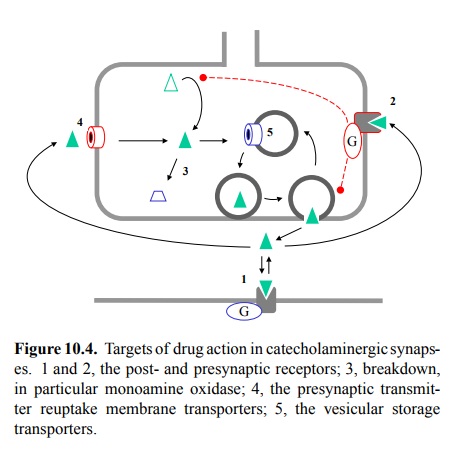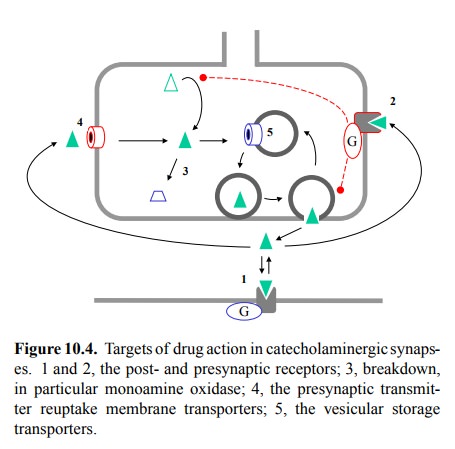Chapter: Biochemical Pharmacology : G protein-coupled receptors
Drug targets in catecholaminergic synapses

Drug targets in
catecholaminergic synapses
In an catecholaminergic synapse, we find several
sites that can be targets of drug action (Figure 10.4):
1. The most straightforward one is, of course, the
postsy-naptic receptor, to which both agonists and antagonists will bind. As we
have seen before, these receptors oc-cur in various types and subtypes. With
the three physiological catecholamines, there is a fairly clear distinc-tion
between the α- and β-receptors on one hand, which respond to
epinephrine and norepinephrine but not dopamine, and the dopaminergic
receptors. The major functional difference between epinephrine and
nore-pinephrine consists in their activity on the β2
receptor subtype, which is very sensitive to the former but not the latter.
Synthetic agonists and antagonists (which may or may not closely resemble the
natural catecholamines in structure) often have superior type and subtype
selectiv-ity, which is both theoretically interesting and useful in therapeutic
applications.
2. The presynaptic feedback receptor. In
noradrener-gic synapses, this is the α2 receptor. In dopaminergic synapses, the main inhibitory receptor
is the D2 receptor.
Both α2 and D2
receptors also occur postsynaptically, so their function is not limited to
presynaptic inhibition1.
3. The degradative pathway. Inhibitors of MAO were
among the first drugs used in both anti-hypertensive and psychiatric therapy.
Though effective, they are not used very much today, for reasons that will
become apparent below. Inhibitors of COMT are used in combination with L-DOPA
in the therapy of Parkinson's disease (see below).
4. The reuptake membrane transporter in the
cytoplas-mic membrane. The transporters found in serotonin-ergic, dopaminergic
and noradrenergic synapses are highly homologous to one another, and they are
some-what promiscuous with respect to their substrates (e.g., the
norepinephrine transporter will transport dopamine with appreciable speed, and
vice versa). This also applies to several inhibitors of reuptake, e.g.
co-caine, which inhibits the reuptake of dopamine, nore-pinephrine, and
serotonin (see below). To a lesser de-gree, the homology also applies to the
reuptake trans-porters for glutamate, GABA and glycine, which sug-gests the
possibility of even wider-ranging drug effects.
5. The vesicular transmitter transporter. This
transporter is structurally and functionally different from the trans-porter in
the cytoplasmic membrane and accordingly affected by different drugs and
mechanisms of drug action.

Related Topics